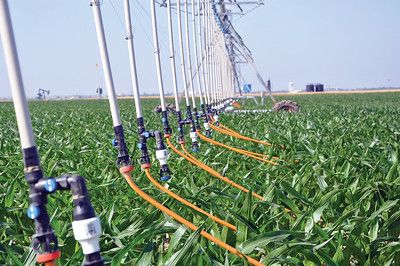5 Solutions to Agricultural Pollution Discussed
Solutions to agricultural pollution are; minimal chemical usage, agricultural waste management, renewable energy adoption (like agrivoltaics), soil and water conservation, as well as sustainable farming practices like organic farming and conservation tillage.
This article discusses the solutions to agricultural pollution, as follows;
1). Minimal Chemical Usage (as one of the Potential Solutions to Agricultural Pollution)
Minimal chemical usage in agriculture is simply the deliberate reduction of the use of chemicals like fertilizers, herbicides and pesticides, to mitigate the risk of environmental degradation.
Reducing the rate at which chemicals are utilized for the optimization of agricultural production, is a crucial step to protect the ecosystem from potentially-negative environmental impacts of these chemicals [3].
There are various measures and steps that can be taken to reduce agricultural chemical usage.
Sustainable farming practices and principles are effective for providing safer alternatives to chemicals. These practices and principles include composting; whereby organic biomass is used in place of synthetic chemicals, as fertilizer for soil enhancement.
In sustainable farming, biological-control techniques can also be used to address pest and disease problems.
Other methods like conservation tillage, cover cropping and crop rotation can make soil and crops to be resilient, so that they can withstand agents of erosion, as well as diseases and pests.
Soil tests can be performed routinely to ensure that fertilizer concentration does not exceed safe levels, while regulations can be enforced to control the use of chemicals on agricultural lands.
A summary of ways to reduce the use of chemical fertilizers, herbicides and pesticides is listed as follows;
1. Composting
2. Crop rotation
3. Regulation of chemical use
4. Cover cropping
5. Conservation tillage
2). Agricultural Waste Management
Agricultural waste management is essential to solve problems of agricultural pollution, because these problems often originate from waste materials.
Through agricultural waste management diverse environmental issues can be addressed; including greenhouse emission from decomposing waste, pathogenic water pollution, and air pollution by sulfuric and nitrous oxides from livestock slurry.
There are different methods that can be applied to effectively manage agricultural waste.
Composting manages waste on farms by converting the waste to useful organic fertilizer. This ensures that toxic output to the environment is minimized, while supplying nutrients to soil, and improving soil properties like moisture retention capacity (alternatively called Plant-Available Water Capacity; PAWC) [1].
Techniques like mulching can put organic waste to healthy use on farms.
Agricultural waste may also be used as a source of bioenergy and biofuel, in what is generally referred to as waste-to-energy conversion.
Waste-to-energy techniques include anaerobic digestion, by which livestock manure and crop residue can be transformed to combustible biogas [2]. Such processes are particularly helpful because they leave residues like digestate, that are relevant as soil amendments.
Guidelines and regulations can play a role in effective waste management, for large farms and agricultural projects.
Below is a summary of ways to manage agricultural waste;
1. Waste-to-energy conversion
2. Recycling of reusable waste materials
3. Regulation enforcement
4. Composting
3). Renewable Energy Adoption (as one of the Potential Solutions to Agricultural Pollution)
Adopting renewable energy in place of non-renewable energy resources can be very beneficial to agricultural projects, in terms of efficiency, productivity and sustainability.
Most of the well-known renewable energy technologies like solar panels and wind turbines, require a one-time installation cost, with minimal maintenance requirements thereafter. This can enable farmers save cost significantly.
In addition to reducing reliance on fossil fuels, or on the electricity grid; renewable energy adoption can be a means by which farmers earn income, by feeding excess power to the grid [4].
Farm waste can be transformed to a source of renewable energy through waste-to-energy practices that double as a sustainable way to dispose of agricultural waste materials.
By adopting renewable energy, the carbon footprint and environmental impact of agriculture can be significantly reduced. Renewable energy resources are less prone to greenhouse and toxin emissions. This implies that their usage mitigates not only pollution, but also climate change and global warming.
In summary, renewable energy can benefit agriculture through;
1. Energy cost-savings
2. Carbon footprint reduction
3. Energy reliability and independence
4. Revenue generation
5. Waste management

4). Soil and Water Conservation
Soil and water conservation, when implemented either individually or in combination, can help solve agricultural pollution problems.
The ability of soil conservation to mitigate pollution in agriculture, comes from the fact that soil is often an accumulation-site for chemicals that can act as pollutants in large concentration.
Practices that aim to conserve agricultural soil resources include; rotational grazing, conservation tillage, strip cropping, crop rotation, terracing, mulching and cover cropping. These practices address some of the issues that cause farmers to rely on synthetic chemicals, like; fertility loss and weed growth. As a result, implementing them (soil conservation-practices) is equivalent to providing a sustainable substitute to potentially-harmful substances.
Water conservation is a means of solving agricultural pollution problems because it reduces the amount of waste produced in agricultural facilities and lands; while limiting the mobility of potential-pollutants that are waterborne.
Practices like sustainable irrigation are part of efforts to conserve water in agriculture, and can reduce wastewater generation as well as pollutant-mobility.

5). Sustainable Farming Practices (as one of the Potential Solutions to Agricultural Pollution)
The principles of sustainable agriculture aim to maximize productivity while protecting the environment from negative impacts; like pollution.
Nearly all applicable measures to solve agricultural pollution problems, can be classified as sustainable farming practices, due to the prioritization of environmental protection in sustainable farming as a whole.
For example, conservation agriculture is a sustainable farming concept that does not directly address pollution, but can still reduce it by focusing on ways to reduce soil disturbance, water wastage and fertility-depletion.
Other sustainable practices like agroforestry and crop rotation increase resilience of the farm to the occurrence and impacts of pests and diseases; thereby causing such farms to require less pesticide-application.
The role of sustainable farming practices in solving agricultural pollution problems is closely tied to other potential solutions like minimal chemical-usage, water and soil conservation.
Conclusion
Solutions to agricultural pollution are;
1. Minimal Chemical Usage
2. Agricultural Waste Management
3. Renewable Energy Adoption
4. Soil and Water Conservation
5. Sustainable Farming Practices
References
1). Arumolzhi, E.; Khan, F.; Basak, Jk.; Park, J.; Okyere, F. G.; Lee, Y. J.; Kim, H. T. (2020). "Analysis of water retention capacities of various compost and its relationship to strawberry moisture level." Acta Horticulturae, GreenSys2019 - International Symposium on Advanced Technologies and Management for Innovative Greenhouses, Angers (France). Available at: https://doi.org/10.17660/ActaHortic.2020.1296.114. (Accessed 25 May 2023).
2). Cahyono, N.A. D.; Shamsuddin, R.; Ayuob, M.; Mansor, N.; Isa, N. H. M.; Gunny, A. A. N. (2021). "Anaerobic co-digestion of chicken manure with energy crop residues for biogas production." IOP Conference Series Earth and Environmental Science 765(1):012044. Available at: https://doi.org/10.1088/1755-1315/765/1/012044. (Accessed 25 May 2023).
3). Carvalho, F. (2027). "Pesticides, environment, and food safety." Food and Energy Security 6(2):48-60. Available at: https://doi.org/10.1002/fes3.108. (Accessed 25 May 2023).
4). Ismail, M. S.; Moghavvemi, M.; Mahlia, T. M. I.; Muttagi, K. M.; Moghavvemi, S. (2015). "Effective utilization of excess energy in standalone hybrid renewable energy systems for improving comfort ability and reducing cost of energy: A review and analysis." Renewable and Sustainable Energy Reviews, Elsevier, vol. 42(C), pages 726-734. Available at: https://doi.org/10.1016/j.rser.2014.10.051. (Accessed 25 May 2023).




